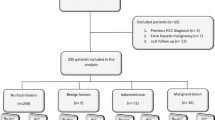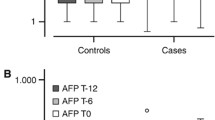Abstract
Purpose
This study is aimed to determine the performance of alpha-fetoprotein (AFP) as part of hepatocellular carcinoma (HCC) screening in a non-viral cirrhosis population.
Methods
A retrospective audit was conducted of patients with non-viral cirrhosis over a 13 year period managed at a single centre. All patients were investigated routinely for evidence of viral hepatitis; patients with positive results were excluded from analysis. Cirrhosis was defined on basis of clinical, biochemical, and radiological investigations and examinations. All patients underwent HCC screening with 6-monthly AFP measurement and 6–12-monthly upper abdominal ultrasound (US). Diagnosis of HCC was confirmed by biopsy, definitive imaging, or natural disease progression.
Results
Sixty-seven patients were included (49 males, average age 58.7 years). Of 14 patients who developed HCC during the study period, 12 patients had HCC detected via screening. Of the screening diagnosed HCC cases, four (33%) patients had a normal AFP with abnormal surveillance US, three (25%) had raised AFP with normal surveillance US, and five (42%) had concurrent AFP elevation and US abnormality. Patients with raised AFP and normal surveillance US had HCC diagnosed after a progressive rise in AFP precipitated imaging with alternative modalities. Within the 53 patients who remained free of HCC, a raised AFP precipitated additional imaging on 10 occasions. HCC was diagnosed in 12 out of 64 patients over a total of 4292 screening months giving an annual incidence of 3.35%.
Conclusions
Twenty-five percent of HCC occurring in non-viral cirrhosis will be detected earlier using a surveillance program incorporating both AFP and US compared to imaging alone programs.

Similar content being viewed by others
References
Australian Cancer Incidence and Mortality (ACIM) books (AIHW). 2017; Available from: http://www.aihw.gov.au/acim-books/.
AIHW. Cancer survival and prevalence in Australia: period estimates from 1982 to 2010. Cancer series no. 69. Cat. no. CAN 65. 2012 19/3/17].
Organisation, W.H. International Agency for Research on Cancer: GLOBOCAN 2012: estimated cancer incidence, mortality and prevalence worldwide in 2012: fact sheet liver cancer. 2012; Available from: http://globocan.iarc.fr/Pages/fact_sheets_cancer.aspx.
Llovet JM, et al. Natural history of untreated nonsurgical hepatocellular carcinoma: rationale for the design and evaluation of therapeutic trials. Hepatology. 1999;29(1):62–7.
Andermann A, et al. Revisiting Wilson and Jungner in the genomic age: a review of screening criteria over the past 40 years. Bull World Health Organ. 2008;86(4):317–9.
Huang YC, et al. Community-based screening for hepatocellular carcinoma in elderly residents in a hepatitis B- and C-endemic area. J Gastroenterol Hepatol. 2011;26(1):129–34.
Parkin DM. The global health burden of infection-associated cancers in the year 2002. Int J Cancer. 2006;118(12):3030–44.
Bruix J, Sherman M. Management of hepatocellular carcinoma: an update. Hepatology. 2011;53(3):1020–2.
El-Serag HB, Davila JA. Surveillance for hepatocellular carcinoma: in whom and how? Ther Adv Gastroenterol. 2011;4(1):5–10.
Lui H-F. Screening for hepatocellular carcinoma. Int J Hepatol. 2011;2011:4.
Sherman M, et al. Screening for hepatocellular carcinoma: the rationale for the American Association for the Study of Liver Diseases recommendations. Hepatology. 2012;56(3):793–6.
Kansagara D, et al. Screening for hepatocellular carcinoma in chronic liver disease: a systematic review screening for hepatocellular carcinoma in chronic liver disease. Ann Intern Med. 2014;161(4):261–9.
Singal AG, et al. Effectiveness of hepatocellular carcinoma surveillance in patients with cirrhosis. Cancer Epidemiol Biomark Prev. 2012;21(5):793–9.
Chang TS, et al. Alpha-fetoprotein measurement benefits hepatocellular carcinoma surveillance in patients with cirrhosis. Am J Gastroenterol. 2015;110(6):836–44. quiz 845
Sturgeon CM, et al. National Academy of Clinical Biochemistry Laboratory Medicine Practice Guidelines for use of tumor markers in liver, bladder, cervical, and gastric cancers. Clin Chem. 2010;56(6):e1–48.
Arrieta O, et al. The progressive elevation of alpha fetoprotein for the diagnosis of hepatocellular carcinoma in patients with liver cirrhosis. BMC Cancer. 2007;7:28.
Tayob N, et al. Improved detection of hepatocellular carcinoma by using a longitudinal alpha-fetoprotein screening algorithm. Clin Gastroenterol Hepatol. 2016;14(3):469–75. e2
Mancebo A, et al. Annual incidence of hepatocellular carcinoma among patients with alcoholic cirrhosis and identification of risk groups. Clin Gastroenterol Hepatol. 2013;11(1):95–101.
Fattovich G, et al. Hepatocellular carcinoma in cirrhosis: incidence and risk factors. Gastroenterology. 2004;127(5 Suppl 1):S35–50.
Omata M, et al. Asian pacific association for the study of the liver consensus recommendations on hepatocellular carcinoma. Hepatol Int. 2010;4(2):439–74.
Lok AS, et al. Des-gamma-carboxy prothrombin and alpha fetoprotein as biomarkers for the early detection of hepatocellular carcinoma. Gastroenterology. 2010;138(2):493.
Sangiovanni A, et al. The natural history of compensated cirrhosis due to hepatitis C virus: a 17-year cohort study of 214 patients. Hepatology. 2006;43(6):1303–10.
Caturelli E, et al. Diagnosis of liver nodules observed in chronic liver disease patients during ultrasound screening for early detection of hepatocellular carcinoma. Am J Gastroenterol. 2002;97(2):397–405.
Singal A, et al. Meta-analysis: surveillance with ultrasound for early-stage hepatocellular carcinoma in patients with cirrhosis. Aliment Pharmacol Ther. 2009;30(1):37–47.
Zhang BH, Yang BH, Tang ZY. Randomized controlled trial of screening for hepatocellular carcinoma. J Cancer Res Clin Oncol. 2004;130(7):417–22.
Bialecki ES, Di Bisceglie AM. Diagnosis of hepatocellular carcinoma. HPB (Oxford). 2005;7(1):26–34.
Minami T, et al. Serum alpha-fetoprotein has high specificity for the early detection of hepatocellular carcinoma after hepatitis C virus eradication in patients. Medicine (Baltimore). 2015;94(23):e901.
Carville KS, Cowie BC. Recognising the role of infection: preventing liver cancer in special populations. Cancer Forum. 2012;36(1):23–6.
Bolondi L, et al. Surveillance programme of cirrhotic patients for early diagnosis and treatment of hepatocellular carcinoma: a cost effectiveness analysis. Gut. 2001;48(2):251–9.
Atiq O, et al. HCC surveillance: Striving for a Better Balance of Benefits and Harms. Hepatology. 2017;66(3):1002–3.
Author information
Authors and Affiliations
Corresponding author
Ethics declarations
This research was reviewed and approved by the Barwon Health Ethics Committee, reference number 17/38.
Conflict of Interest
The authors declare that they have no conflict of interest.
Rights and permissions
About this article
Cite this article
Worland, T., Harrison, B., Delmenico, L. et al. Hepatocellular Carcinoma Screening Utilising Serum Alpha-Fetoprotein Measurement and Abdominal Ultrasound Is More Effective than Ultrasound Alone in Patients with Non-viral Cirrhosis. J Gastrointest Canc 49, 476–480 (2018). https://doi.org/10.1007/s12029-017-0006-y
Published:
Issue Date:
DOI: https://doi.org/10.1007/s12029-017-0006-y




